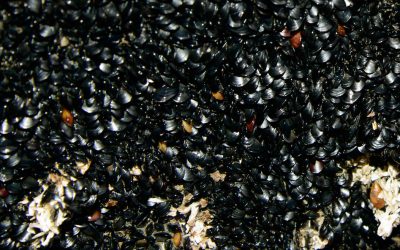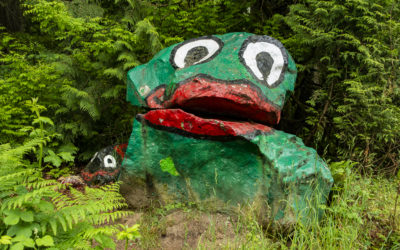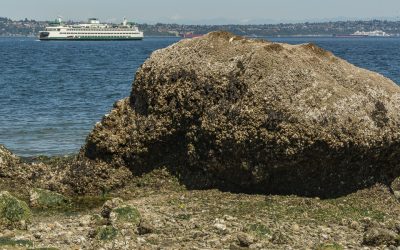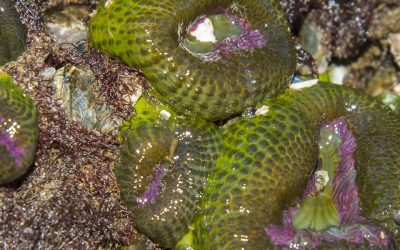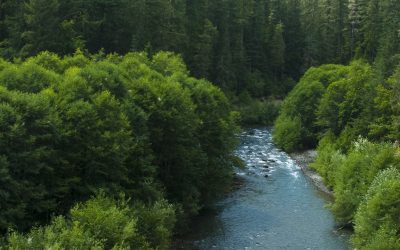Seeing Stars?
A Struggling Keystone SpeciesBy Jeanne Wright, Nancy Sefton
Photos & video by John F. Williams except where noted

Seeing Stars?
A Struggling Keystone Species
By Jeanne Wright, Nancy Sefton, Autumn 2018
Photos & video by John F. Williams except where noted
Audio version
common in the salish sea
Several kinds of colorful sea star species are common in the Salish Sea, but to see them you need to go underwater or visit our shores at low tide. Quite common are the stout 5-armed ochre stars (above), which are not all ochre colored, but can be purple, brown, reddish, yellow or orange. Bright red blood stars, six-rayed stars and leather stars can also be seen on our beaches.
Depending on the species, sea stars can have four arms or more than twenty arms. Tiny tube feet crowd the undersides of the arms and transport oxygen from seawater to the star’s tissues. Yes, you could almost say that sea stars breathe through their feet. The thousands of tube feet on a sea star also move the star along at a slow creep. Recent evidence points to a special adhesive that is secreted by the feet and allows the star to grasp the bottom tightly (It’s a good reason to avoid trying to pull a star from a rock, lest the feet be ripped off!).
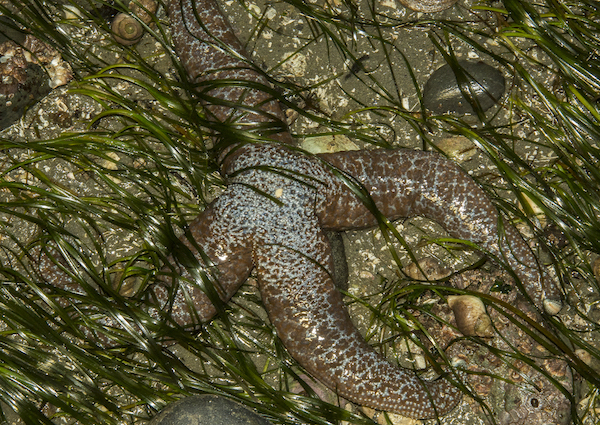
sea stars’ life cycle
Some sea star species have it easy; to reproduce they simply split in two. Males and females of other species release their respective reproductive cells from their arms into the water (broadcast spawning). From the many cells released, only a few become larvae (the juvenile forms of the animal). Larvae look very different from adults. Adrift for months before finally becoming tiny sea stars, they eventually fall to the ocean floor to feed and continue to grow. In general, stars have great longevity: the ochre star can live 20 years, and the sunflower star can live more than 30!
regeneration
Unlike humans, a sea star has the envious ability to regenerate a new arm if one is damaged or lost…but there’s a catch: while the new limb is forming, the animal may not be able to forage for prey with ease, nor reproduce effectively since the gonads (reproductive organs) are located in its arms. Our local species can lose more than one arm, but must retain a portion of the central disk in order to regrow the lost appendages.
wasting disease
Although these hardy marine animals once occupied the Salish Sea in large numbers, they’ve declined in recent years due to Sea Star Wasting Disease along much of the North American Pacific Coast. The impact on our sea stars is not only unfortunate for them, but has consequences for the broader ecosystem because sea stars are considered a “keystone species” — a predator that keeps other animal populations in balance. For example, sea stars feed on sea urchins, limiting their abundance. The urchin population grows when stars’ numbers decline. Overabundance of urchins can lead to a decline in the kelp forests on which the urchins feed. As a result, this important near-shore habitat is threatened as a result of the cascading effects of sea star decline.
sea stars and other marine creatures
Barnacles grow profusely on many surfaces, even atop other marine creatures such as whales and mussels, but you won’t see them on sea stars. A close look reveals many bumps on a star’s surface; some are organs used for cleaning off foreign organisms, like barnacles or algae. Some stars, like the ochre variety, are often found hanging out on barnacle colonies, feeding on barnacles and mussels, and snails.
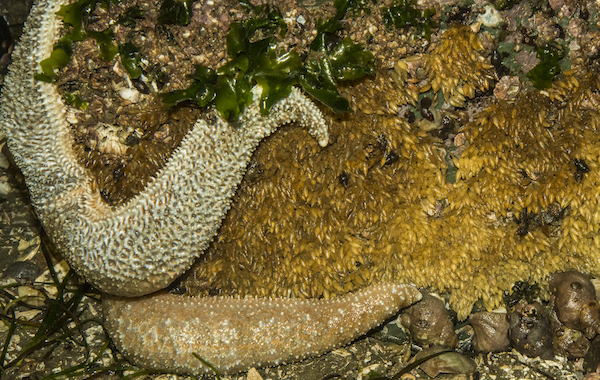
how does the sea star eat?
The “stickiness” of its tube feet is handy when the star wants to eat a shellfish. It attaches to the shells with its feet and slowly pries open the shells. Then it pushes its stomach from its body and into the shellfish. A secreted enzyme breaks downs the victim’s soft parts into a slurry, allowing the star to absorb its liquefied meal into its stomach. Also see “Find Out More” for a link to a movie from the point of view of the mussel.
Both stars and anemones are predators, but when it comes to attacking each other, it’s a one-way street. Sea stars happily dine on anemones, but it’s not the other way around. A clever chemical conversation occurs when a star gets close to its prey. The star’s mucus alerts the anemone to the risk of predation. Despite the anemones ability to creep if necessary, a star can usually “outrun” an anemone. But one, aptly named the swimming anemone (Stomphia coccinea), takes serious action when touched by a particularly dangerous star species by detaching itself from the bottom and “swimming” away. If the marauding star is deemed harmless, however (i.e. doesn’t smell too bad!), the anemone can relax and stay put.
Video by Rendezvous Dive Adventures, Port Alberni, British Columbia
Besides the wasting disease, what other threats do stars face? They are eaten by a variety of creatures, such as shrimp, crabs, and even other sea stars. A much larger enemy, the sea otter, has a varied menu, but a third of its diet consists of sea stars. Seagulls are another major predator, although they seem to prefer smaller sized stars that can be swallowed in a few seconds. It takes longer, up to an hour, for a gull to consume a medium-sized meal such as an ochre or mottled star. Even large sea stars are on the menu, but they’re not swallowed until they’ve been tossed on their bellies and pecked at, or had their arms torn off!
Maybe the large sea star that I found on the pavement of a parking lot in Port Orchard last year was left there by a smaller seagull who dropped it trying to break it apart? Maybe the gull just couldn’t gulp it down?
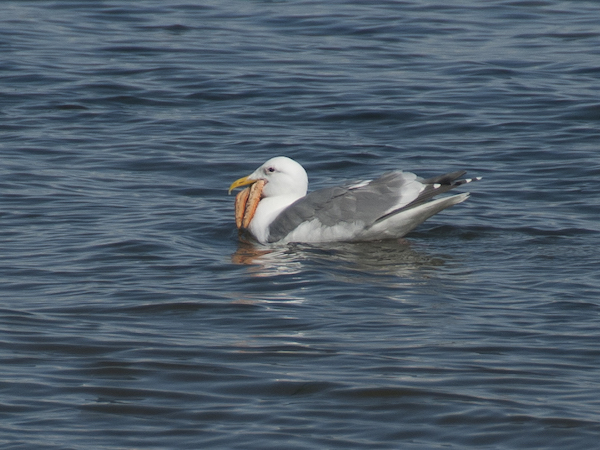
POETRY
Our Lady of the Sea
Poem by Jeanne Wright
Echinodermata
Waves its little arms as the waves wash over
Moves with the grace of a slow dance
The grip of the tiny tube feet on each of her five fingers, crawling along the ocean floor just before everting her stomach, a lovely muscle slurry Slurpee
A full belly and an assisted trip to the shoreline
She grabs ahold of the dock before the tide rolls out…
I find her smashed on the pavement, the lost meal of a seagull.
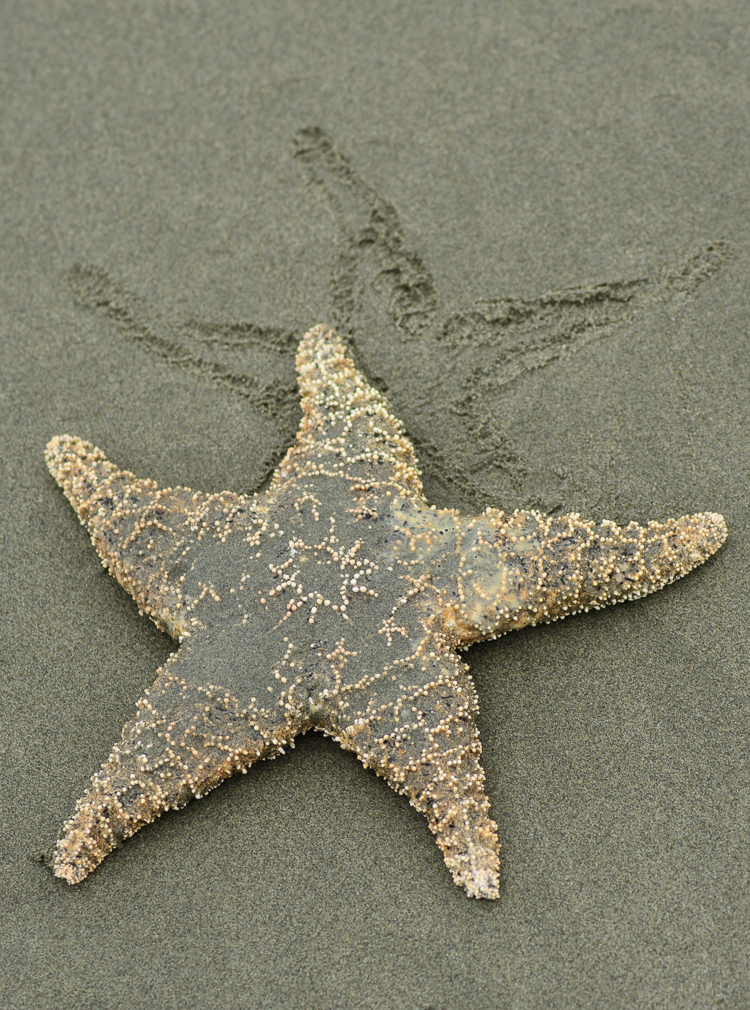
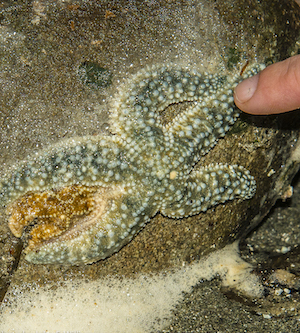
In Spring, 2018, Jeanne Wright was a student at WWU’s Huxley College of the Environment in a class titled “Research of the Salish Sea” taught by Jenise Bauman. Jeanne and other members of her class researched and authored articles for this inaugural issue of Salish Magazine.

Nancy Sefton is an artist, writer, videographer and photographer who specializes in nature subjects. As a former diver she has contributed frequently to national magazines and newspapers, publishing over 300 articles about marine life. Nancy now lives in Poulsbo and writes for Sound Publishing newspapers.
Table of Contents, Issue #1, Autumn 2018
Mussel Strength
How Mussels Serve Our Ecosystem By Jill Needham, Kathleen Alcalá Photos & video by John F. Williams except where notedHow Mussels Serve Our Ecosystem By Jill Needham, Kathleen Alcalá, Autumn 2018 Photos & video by John F. Williams except where notedcommon in...
Big Boulders
By Greg Geehan, John F. Williams Photos & video by John F. Williams except where notedA Place to Attach By Greg Geehan, John F. Williams, Autumn 2018 Photos & video by John F. Williams except where notedMuch of the sand and gravel on Salish Sea beaches comes...
The Barnacle
By Tasha Smith, Leigh Calvez, Deb Rudnick Photos & video by John F. Williams except where notedMore Than Meets the Eye By Tasha Smith, Leigh Calvez, Deb Rudnick, Autumn 2018 Photos & video by John F. Williams except where notedMy first experience with...
Flower of the Tide Pool
By Briana Sandoval Sharon Pegany Photos & video by John F. Williams except where notedPlant or Animal? By Paul Pegany, Summer 2019 Photos & video by John F. Williams except where noted Aggregating anemones are commonly found at low tide around the Salish...
Postscript-1
By John F. Williams Photos & video by John F. Williams except where notedVisualizing an Ecosystem By John F. Williams Photos & video by John F. Williams except where notedTelling the story of a system as complex as the ecosystem we live in is a tall order....
FIND OUT MORE
Oregon Coast Aquarium. Blood Star: https://aquarium.org/animals/blood-star/
Science Learning Hub. A really nice interactive look at some of the features of a generic sea star: https://www.sciencelearn.org.nz/image_maps/46-sea-star-adaptations-dorsal-view
Slater Museum of Natural History. More about the ochre sea star: https://www.pugetsound.edu/academics/academic-resources/slater-museum/exhibits/marine-panel/ochre-sea-star/
UW’s Friday Harbor Labs. More about the swimming anemone: http://depts.washington.edu/fhl/tidebites/Vol24/index.html
Visit the Shape of Life site to see a movie of a sea start eating the mussel, from inside the mussel!
Video of the swimming anemone was from: Rendezvous Dive Adventures
WSU Extension and Still Hope Productions (2014). “Exploring at Low Tide” The video clip describing sea stars feasting on mussels was from this movie.

